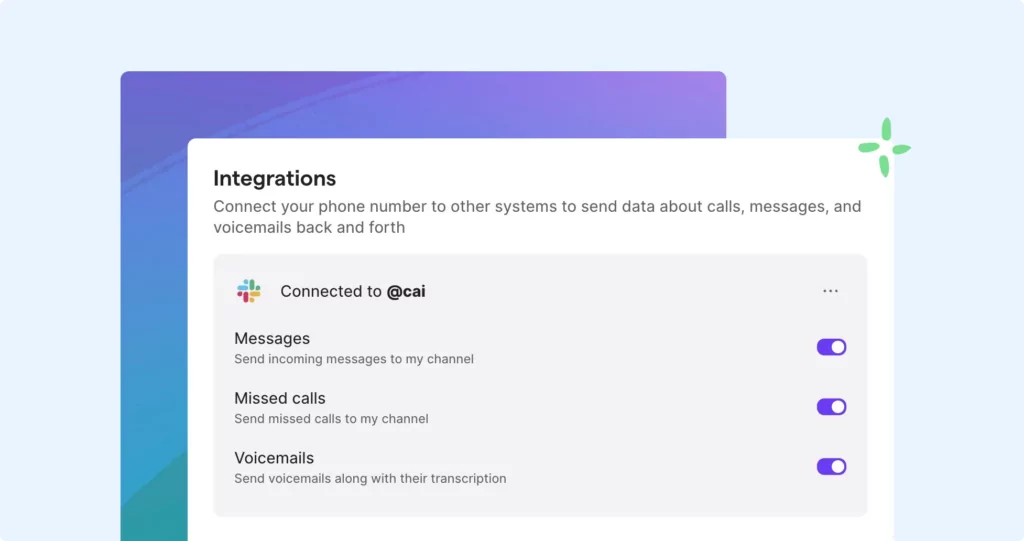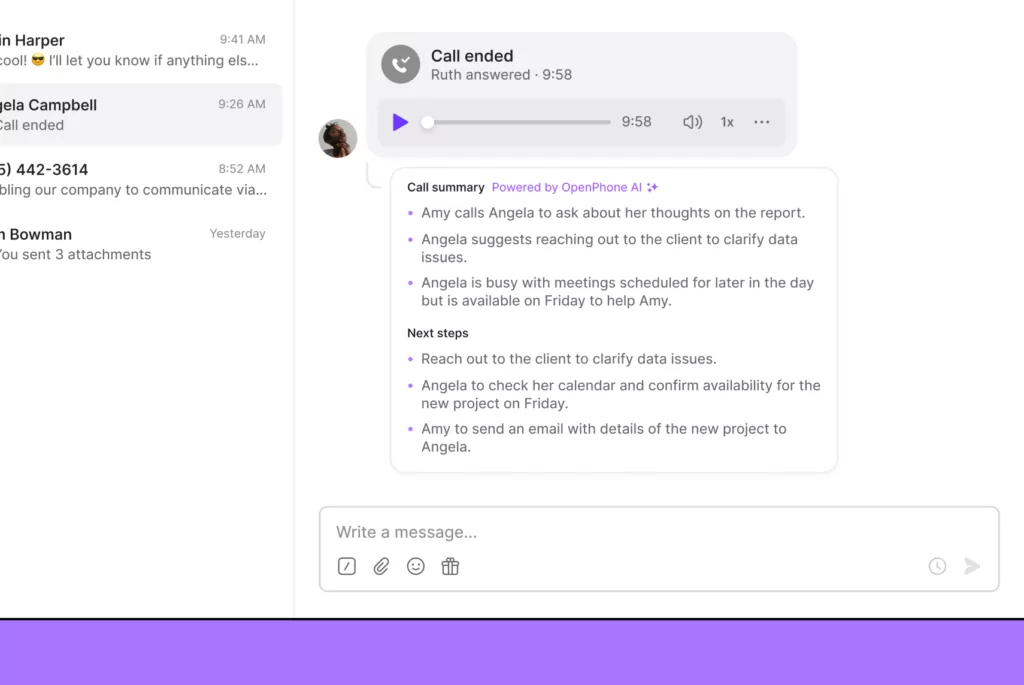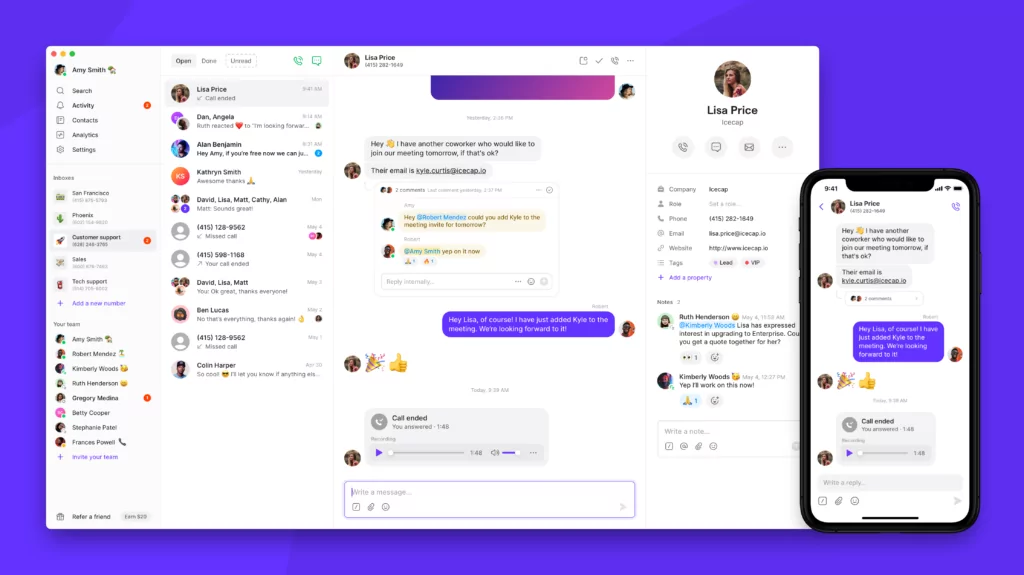You probably remember the best customer service experience you’ve ever had — whether it was the restaurant staff that added a free dessert, a concierge at a hotel who gave you the ideal itinerary, or the Genius at the Apple Store who fixed your broken hard drive.
Because you know how much great customer service means to you, you’re also aware of how important customer satisfaction is to your business.
Customer satisfaction is a valuable metric that can also be difficult to measure. It’s a mix of qualitative and quantitative data that captures high-level sentiment regarding the service you deliver.
If your customer satisfaction is low, it can feel overwhelming to try and improve it. In this article, you’ll learn nine ways to increase customer satisfaction with insights from real CX experts with decades of experience.
How to improve customer satisfaction for your business
Improving customer satisfaction is not something you can set and forget. It’s about addressing issues as they come up throughout the customer experience, as well as arranging your internal team and processes around customer happiness.
“The biggest misconception for improving CSAT at scale is that it’s one big gesture that will do it,” says Craig Stoss, Director of CX Transformation Delivery at PartnerHero. “CSAT is not about that ‘one big change;’ it’s a series of small events that lead to higher satisfaction.”
And higher satisfaction leads to positive business outcomes: increased customer retention, more loyal customers, and ultimately, a word-of-mouth referral network that brings in new customers.
With that in mind, here are nine ways to improve customer satisfaction.
1. Integrate your tech stack to deliver a more personalized experience
Just like a menu with your name on it can make your birthday dinner feel more special, more personalization leads to higher customer satisfaction.
According to data from Zendesk, 90% of customers will spend more with companies that personalize the customer service they offer them.
This presents a huge opportunity for your business to stand out and deliver experiences customers will flock to you for.
“High-context support requires integrations between all of your tech stack and surfacing those details inside your support team’s help desk,” Craig says. “Remove the need to ask the client for information you already have somewhere or have the support agent spend time searching and copying that data.”
Craig recommends that information like order numbers, shipping details, customer status, contract value, location, previous tickets, and product usage data should be instantly available to customer support agents.
It will help your support team answer customer questions faster and enables customer service automations that allow teams to streamline processes. Keeping all the data in one accessible place makes all customer interactions more efficient. This matters in the high-stakes world of customer support when the difference between a good and a bad experience is how much time is spent on a phone call.
2. Measure customer satisfaction with multiple scores and insights
You can’t manage what you don’t measure — that’s why you need to track your customer satisfaction score (CSAT).
“There needs to be a survey in place…and then classifying why each customer satisfaction score was given into categories shows you the drivers of satisfaction and dissatisfaction,” says Nykki Yeager, CEO of Flight CX. “You can then work cross-functionally to address those.”
The most popular CX metrics are CSAT and Net Promoter Scores (NPS). Follow those metrics up with First Response Time (FRT), Average Handle Time (AHT), and Time to Resolution (TTR).
Craig recommends that businesses also use Customer Effort Score (CES) and Value Enhancement Score (VES).
“Those are really important because [they] tell you if you have put too much onus on the customer or if the end result was not as useful as anticipated,” says Craig. Craig also recommends adding qualitative insights to quantitative metrics. By doing so, you can transform a “performance conversation into a value conversation” and achieve a better understanding of how satisfied your customers actually are.
A quick refresher on customer satisfaction KPIs
Need a quick review of CSAT, NPS, and more? We’ve got you covered:
Customer satisfaction score (CSAT): Tracks how satisfied a customer is with your business.
Ask your customers how satisfied they were with a particular interaction or experience with your business on a scale of 1 to 5. If you ask them multiple questions, take the average score of their responses — that’s your CSAT.
Net Promoter Score (NPS): Tracks customer loyalty and satisfaction.
Ask customers how likely they are to recommend your product or service to others, usually on a scale from 0 to 10.
First response time (FRT): Tracks how quickly team members are able to respond to customer inquiries.
Average handle time (AHT): Determines the average time team members spend on support calls with customers.
Time to resolution (TTR): Calculates the time it takes for team members to resolve support issues from start to finish.
Customer effort score (CES): Measures the ease with which customers can get their issues resolved or achieve their goals using a product or service.
Ask customers questions like “How easy was it for you to resolve your issue with our customer service team?” or “How easy was it to purchase a product on our website?”
Score their responses on a scale of 1 to 5, with 1 representing “Very Easy” and 5 representing “Very Difficult.” The average of these responses will be your business’s CES.
Value Enhancement Score (VES): Aims to measure the perceived value a customer gains from a product or service.
Each business’s concept of VES is different, but you can rate your customer’s perception of value on a five-point scale, similar to CES, by asking them questions like “How would you rate the value you receive from our service compared to the price you pay?” or “How has our product/service enhanced your [specific outcome]?”
3. Use AI chatbots for better self-serve support
Recent advances in generative artificial intelligence (generative AI) benefit both customers and support teams by offering high-quality self-service support faster and reducing a support team’s workload.
AI chatbots are chat interfaces powered by artificial intelligence, designed to give customers answers to questions from a team’s help center, knowledge base, and/or other resources.
Customers are overwhelmingly positive about AI chatbots: according to Zendesk, over 70% of consumers believe AI/bots contribute to faster replies and are helpful for simple issues.
To better align with customer expectations, you should consider implementing an AI chatbot into your omnichannel customer service experience, if you haven’t already.
4. Execute customer journey flows to build empathy
A customer journey map shows the steps a customer goes through from the first interaction with your service to the last. It allows you to step into your customer’s shoes and experience your business from their perspective.
For example, if you run a real estate agency, try scheduling a viewing with one of your agents and documenting what the experience is like.
In particular, note the friction points in the flow. Then ask your team:
- What do our most dissatisfied customers complain about?
- What, if anything, are we currently doing to address these issues?
From there, you can develop ways to eliminate the pain points from your current process.
Finally, document the success or failure of these development efforts: has customer retention improved? Are you winning new business as a result of your changes?
5. Increase customer-centricity by having everyone in your team interact with customers
A customer journey map is not the only way to build empathy. You can also create opportunities for everyone in your business to interact with customers and learn about their needs.
As teams grow, they can get siloed from customer interactions and forget about their responsibilities to the people they serve. This is natural, as specialists focus on ever-narrower aspects of the business.
However, some very successful companies — such as Zapier and Basecamp, implement all-hands support to make sure everyone has regular contact with customers.
Beyond scheduling support shifts, you can have members of other teams join your sales team on a customer visit or demo call. Creating these regular touchpoints benefits your business as a whole.
A recent McKinsey case study profiled a Chinese steel manufacturer that invested in processes to build a more customer-centric organization. By implementing an omnichannel customer feedback experience, including periodic on-site interviews, feedback sessions conducted by Marketing and CX teams, surveys on mobile devices, a WeChat portal, and more, the organization was able to surface insights they had previously ignored.
This customer experience overhaul led to “an estimated 4% increase in gross profit, or an 8% increase in pre-interest and pretax profit” and a healthier, more efficient organization.
6. Share all feedback with your team in real time
Whether you receive positive or negative feedback, keeping up on the latest comments in real time can help you resolve issues faster and improve your service.
Sharing feedback with your team in real time can help you reduce customer churn. At OpenPhone, it’s one of the ways we manage customer relationships. “If a high-value customer shares a bad CSAT, our customer success manager managing the account will get looped in, and our most senior members on the team will get looped in to work with the customer to resolve their issues,” says Sunny Tripathi, Sr. Support Operations Manager at OpenPhone.
One way you can automate feedback sharing is to connect your company’s internal communication channels, like Slack, with your customer feedback channels. For example, you can trigger your Trustpilot account to send a message to your team immediately after a new review has been posted. This way, if necessary, the right team member can follow up promptly.

You can give your team entire team visibility into the conversations you’re having with customers using the OpenPhone Slack integration. Your team can also capture notes about a customer within OpenPhone so any colleague can pick up and continue any conversation.
7. Offer omnichannel support
A great customer experience allows customers to reach you using the channel they prefer, which means having a presence everywhere.
According to Zendesk, 93% of customers will spend more money with companies that offer their preferred option to reach customer service.
If you sell a complex product, offer customers the ability to get in-depth answers instantly with self-service features such as an AI chatbot or an online knowledge base.
If you’re a service-based small business, a knowledge base (beyond an FAQ page) doesn’t make sense because customers often need your help to resolve their issues.
If a customer wishes to switch channels for better support, such as texting vs phone calls, give them the ability to switch channels within the same ticket based on what’s comfortable for them.
8. Understand the root cause of an issue and fix it
You know your employees and your customer base best. Not every problem or solution can be contained in CSAT surveys, journey maps, or support tickets. Take time to understand what’s really affecting your customers by identifying the root cause of the issue and addressing that.
For example, if you’re running a restaurant, negative feedback you might hear from customers is that their food is being served cold.
The obvious fix for this problem is to prepare dishes closer to when they’re being ordered by customers. However, if you’re facing the primetime dinner rush, this is not always feasible.
You’ll have to dig deeper to find the root cause. One of the most popular methods for root cause analysis is called the Five Whys, and it’s exactly what it sounds like. You start with the initial problem and ask, “Why is that?” as many times as you need before getting to the root issue.
In the restaurant example, this might look like:
- Why did we get 3 negative reviews in a row on Yelp? Because dishes are coming out cold.
- Why are dishes coming out cold? Because servers aren’t picking them up fast enough.
- Why are servers not picking dishes up fast enough? Because they have too many tables to manage.
- Why do they have too many tables to manage? Because we are short of staff.
By doing a root cause analysis, you find that servers are spread thin, which means they leave dishes on the service counter longer than they should. To fix this, you can hire more servers , or you can add a food runner who is specifically responsible for bringing food out to customers.
9. Surprise and delight customers as perks for their loyalty
One way you can improve your customer satisfaction — and even turn your satisfied customers into brand evangelists — is to recognize their loyalty.
“Show your customers that not only is your customer service good, but because of their loyalty, they can get little perks,” says Craig. “For example, giving them a discount when prices increase or sending them an unexpected gift during a holiday.”
You don’t always have to spend money to delight a customer. For instance, featuring them on your website or LinkedIn profile can benefit them as well while generating positive publicity for your business.
These small acts of recognition go a long way toward building goodwill with your best customers.
What influences customer satisfaction?
Customer satisfaction is often unrelated to your brand or product, but rather how well you fit customer needs and how good a customer feels about your team and service.
When you find gaps in your customer satisfaction data, try asking these questions.
Do your customers trust you and give you feedback?
Getting feedback from customers is the first step to understanding what you can improve.
But you can’t sit back and wait for customers to offer you feedback directly in your support channels, especially if you’re hoping for positive feedback. You have to actively ask for feedback through customer satisfaction surveys. Then you can interact with customers via social media and comb through apps like G2, Yelp, Trustpilot, and Google to see what customers are saying.
If they’re not saying anything at all, you may need to work on creating channels for two-way communication that will pave the way for building customer trust.
Do you listen to your customers?
If you aren’t listening to your customers, their feedback won’t be documented and translated into action steps.
Listening to customers is more than just triage. Beyond taking their call and responding to their pain points, set up processes to solve those issues for future customers.
Get permission from customers to record your calls with them in advance so you can capture their feedback in their own words and share it with your team.

Call transcripts with AI summaries can also help you synthesize this information faster and make it easier to reference later.
Do you act on customer feedback quickly and appropriately?
When customers share negative feedback, they either feel like your team didn’t adequately address their concerns or want you to solve their issue as quickly as possible.
Set service-level agreements (SLAs) for your first response times to hold your team accountable to certain standards.
Do you measure customer satisfaction consistently?
As indicated above, CSAT surveys and NPS scores tell you whether your customer satisfaction is trending up or down.
You can also include qualitative insights that complement your quantitative data, such as comments or threads to add context or draw attention. If there’s a specific reason for why your scores are up or down in a given month, call it out so your team can work to address it.
Customer satisfaction starts with putting the right tools in place
Customer satisfaction hinges on listening and iterating on feedback that’s actionable.

OpenPhone is a business phone system that lets you have a clear line of sight into the conversations your team has with customers. You can easily see the full conversation history with AI-generated transcripts and call summaries when you want to dive into the details and coach your team as needed.
See for yourself why thousands of customer-facing teams use OpenPhone by testing out OpenPhone on a free, seven-day trial. Then when you’re ready, you can easily port any existing local US, Canadian, or North American toll-free number over.

